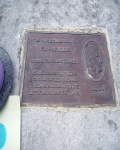Father Pat Noise
Archaeology »
Archaeological Monuments » Father Pat Noise
Father Pat Noise - Ireland
Father Pat Noise is located in O'Connell Bridge,Dublin.
Father Pat Noise monument was established on 1920.
Primary threats to Father Pat Noise :
The plaque was laid in a depression left by the removal of the control box for the "Millennium Countdown" clock installed in the waters of the Life in March 1996 as a countdown to the Year 2000.
Historical facts of Father Pat Noise :
- Father Pat Noise, a prominent figure in Irish history, played a significant role during a critical period of Ireland's struggle for independence. Despite the limited information available about him, his actions and contributions have left a lasting impact on the nation. Let's explore the historical facts surrounding Father Pat Noise.
- Father Pat Noise, whose full name was Patrick Joseph Noone, was born in County Mayo, Ireland, in 1884. He grew up in a predominantly Catholic community and developed a strong sense of Irish nationalism from an early age. Noise was ordained as a priest and served in various parishes, but it was his involvement in the Irish Republican Brotherhood (IRB) that would shape his place in history.
- The IRB, an underground nationalist organization, sought to achieve Irish independence from British rule. Father Pat Noise became a key member of the IRB and played an active role in organizing and supporting the Irish volunteers in their struggle against British forces.
- During the Easter Rising of 1916, Father Pat Noise displayed immense courage and leadership. The Easter Rising was a rebellion against British rule in Ireland, and Noise served as a chaplain to the rebels. He provided spiritual guidance, administered the last rites to the fallen, and offered support to the wounded. His presence on the front lines during the uprising highlighted his dedication to the cause of Irish independence.
- After the Easter Rising, Father Pat Noise faced significant consequences for his involvement. He was arrested and imprisoned by the British authorities. However, Noise's commitment to his beliefs remained steadfast. Even during his time in prison, he continued to advocate for Irish independence and refused to compromise his principles.
- Upon his release, Noise resumed his work as a priest and continued to support the Republican cause. He played an active role in organizing and mobilizing communities, promoting Irish culture and language, and providing aid to those affected by the ongoing struggle for independence.
- Father Pat Noise's dedication to Irish nationalism and his involvement in the struggle for independence made him a revered figure among his compatriots. He became a symbol of resistance and resilience, representing the unwavering spirit of the Irish people during a tumultuous time in their history.
- Tragically, Father Pat Noise's life was cut short in 1923 when he died at the young age of 39. The exact circumstances surrounding his death remain unclear, adding a sense of mystery to his legacy. Nonetheless, his contributions to the Irish nationalist movement and his unwavering commitment to the cause of independence continue to inspire generations of Irish people.
- Father Pat Noise's historical significance lies in his role as a clergyman who actively participated in the fight for Irish independence. His actions exemplify the deep connection between religion, nationalism, and social activism in Ireland during the early 20th century.
- While the available historical records about Father Pat Noise may be limited, his impact on the struggle for Irish independence and his commitment to his beliefs have solidified his place in Irish history. His legacy serves as a reminder of the sacrifices made by individuals who dedicated their lives to the pursuit of freedom and justice for their nation.

